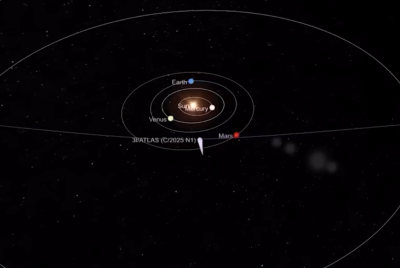3I/ATLAS Stuns Researchers With Surprise Trajectory Change, Ignites Dark-Matter Controversy
Newly released mission imagery and independent analyses show a non-gravitational acceleration that shifted 3I/ATLAS's path toward Jupiter.

An interstellar visitor has adjusted its path in a way that some scientists call coincidental, and others call engineered, reopening a fierce debate about whether natural physics or hypothetical technology explains its behaviour.
The object known as 3I/ATLAS, the third confirmed interstellar interloper observed passing through our solar system, showed a measurable non-gravitational acceleration during perihelion that altered its projected closest approach to Jupiter. That adjustment, small in absolute terms but large in interpretive consequence, brought the object to within the radius of Jupiter's Hill sphere, a coincidence that a minority of researchers say is improbable without purposeful steering. The result is a rigorous scramble among mission scientists, independent analysts, and a vocal subset of theoretical astrophysicists to reconcile high-precision astrometry, spacecraft imagery, and competing explanations.
Trajectory Shift And The Data
NASA's campaign of spacecraft and ground-based observations recorded a non-gravitational acceleration for 3I/ATLAS during its close pass of the Sun, a perturbation the Jet Propulsion Laboratory's Horizons solution folded into its ephemeris and which changed the comet's predicted approach distance to Jupiter. NASA emphasises that the measured deviations are small and consistent with outgassing and other cometary processes; the agency published its data, imagery, and an FAQ to explain why the object remains, by their classification, a comet.
Yet the adjustment is measurable to the level that it alters mission-quality predictions: according to an independent analysis published by Professor Avi Loeb, the corrected minimum separation on 16 March 2026 matches Jupiter's Hill radius to within the quoted uncertainties, a numerical near-coincidence that Loeb argues is one part in a thousand by one measure and one part in 26,000 by another. That statistical framing is the fulcrum of the current controversy because it shifts the conversation from observational footnotes to questions about intent, mechanism, and detectability.
The Debate Over Non-Gravitational Acceleration
Mainstream cometary physics offers a parsimonious explanation: sublimation of ices near perihelion produces jets that impart tiny thrusts and produce non-gravitational forces. NASA's dataset, including Hubble and Webb imaging and spacecraft imagery from Mars orbiters and inner-system probes, documents jets, coma structure, and compositional signatures consistent with an icy nucleus undergoing solar heating. The agency's public briefings and video releases stressed that these signatures fit established comet models and that nothing in the data yet compels extraordinary claims.
Opponents of that consensus, most prominently Professor Loeb, publicly contest both the interpretation and the sufficiency of the search for technosignatures. In a detailed Medium essay and a later live Q&A transcript, he argues that the timing, geometry, and measured acceleration look as though they were tuned to place 3I/ATLAS at Jupiter's gravitational doorstep and that some images show jet geometries not obviously aligned with simple solar heating models. 'You cannot find technological signatures unless you are seeking them,' he told a live audience, and he pressed for broader searches in microwave, infrared, and radar bands.
The Stakes: Science, Skepticism, And Search
What is at stake is not merely a headline but the practice of interpretation under extreme uncertainty. If further high-fidelity data confirms natural outgassing as the complete explanation, researchers will have gained a rare window into the makeup of a planetesimal born around another star and refined models of cometary dynamics at hyperbolic speeds. If, exceptionally, independent observatories detect anomalous emissions, heat signatures, or artefacts near Jupiter after the March 2026 encounter, the implications would be paradigm-shifting. NASA's procedural response has been to release raw data, encourage community analysis, and refrain from conjecture, precisely the posture that Loeb and his supporters say understates the unknowns.
The broader research community is responding in complementary ways: high-resolution infrared observations using Webb, continuous radio surveys for narrowband transmissions, and refined trajectory reprocessing with JPL Horizons are already scheduled or underway. Several independent astrophotographers and amateur observatories have produced high-signal images showing complex jet morphology that professional teams are incorporating into forward models. That multi-pronged approach reflects the correct scientific humility: extraordinary inference requires extraordinary evidence assembled from many independent instruments.
Human drama underpins the technical debate. The intellectual stakes have drawn public policy attention, private research funding, and a new intensity of media scrutiny. The scientific community's cautious, methodical responses coexist uneasily with outspoken calls for rapid, speculative interpretation; the resulting dialogue is a test of how science communicates uncertainty without abdicating curiosity.
The above image of 3I/ATLAS was taken by our @NASAHubble telescope back in July. Learn more about the comet and check out our image gallery: https://t.co/b2wt2bOGBr
— NASA (@NASA) November 17, 2025
What To Watch Next
The world should watch three measurable things: refined astrometric solutions released by JPL, infrared thermometry from Webb that could reveal excess heat, and any detection of satellites or fragments in Jupiter's Hill sphere after 16 March 2026. Each outcome will reduce the hypothesis space and, crucially, will be sourced to primary data rather than commentary. For now, the object remains scientifically invaluable regardless of origin: a rare visitor offering a direct sample of another star system's material and, at the same time, a mirror for the scientific community's standards of proof.
This moment is a reminder that the universe tests our assumptions; how the community answers will define both the next chapter of small-body science and the public's appetite for big questions.
© Copyright IBTimes 2025. All rights reserved.




















